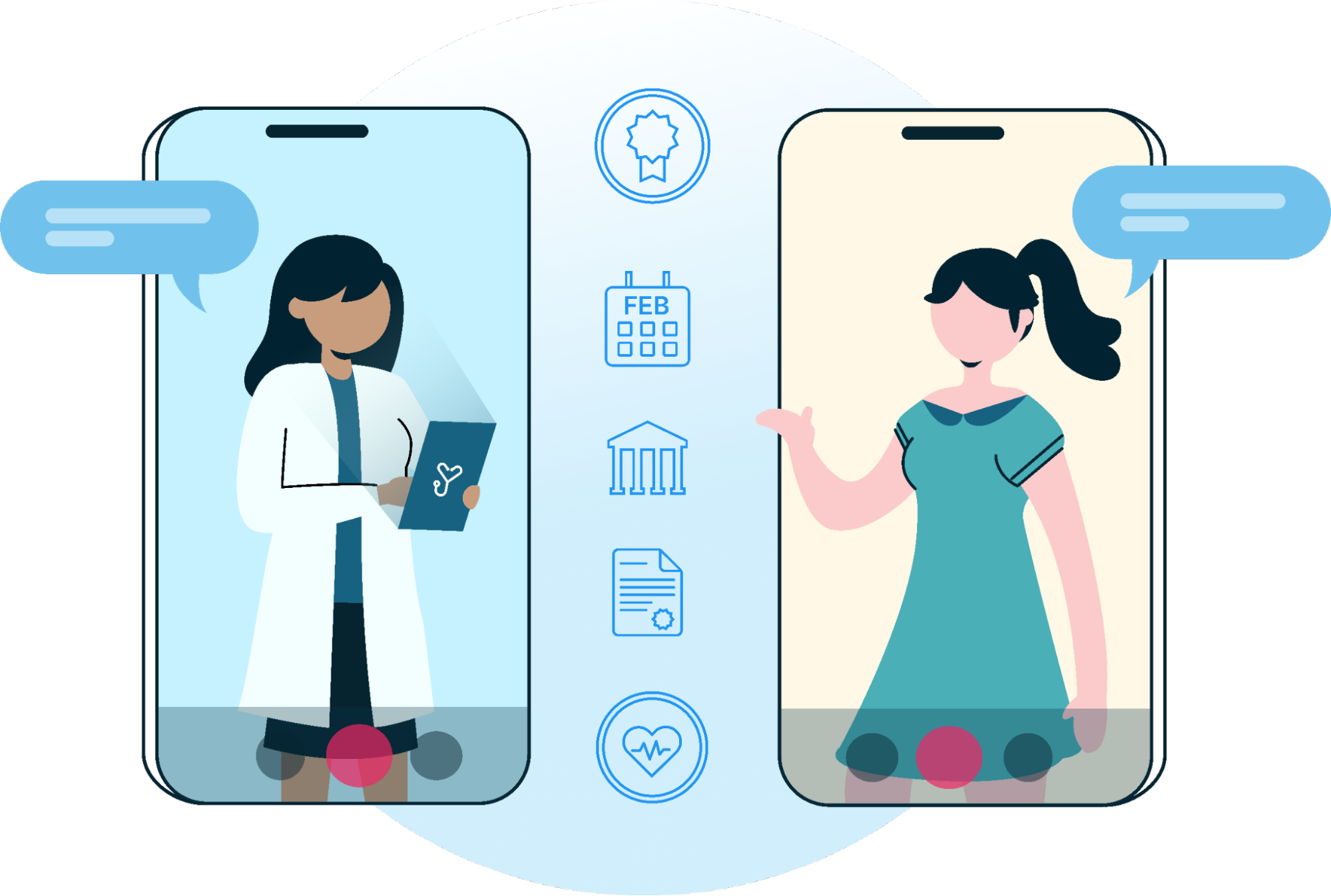How to Plan for & Profitably Operate a Telehealth Program

A great telehealth program is true to the core values of the healing arts. Since ancient times, therapies have sought to combine empathy, knowledge, and tools at hand to ease the suffering of others. The rise of computing has brought video meetings from the boardroom to the living room. With telehealth programs, health systems have a unique opportunity to make quality remote medical care accessible to all.
What are the benefits of telehealth?
A well-run telehealth program touches every sphere of a health system. Patients enjoy easier access to care, better clinical outcomes, and more satisfaction. Staff benefits from streamlined workflows and the ability to work from outside their offices. On the business end, telehealth programs reduce costs, eliminate free care, and create new revenue streams.
How do you set up a profitable telehealth program?
Managers need not tread new ground. By following a step-wise approach, health systems can design a telehealth program that meets their team’s needs. A crucial step is to partner with an experienced software provider that can help your team reach its goals.
The Case for Telehealth
A 2017 article published in the New England Journal of Medicine identified five key drivers for the growth of telehealth:
Drivers of telehealth program growth:
1. The rise of consumer goods such as wearable sensors and wireless monitors.
2. Advances in EHR and clinical decision support systems that can “talk to†telehealth service platforms. This integration boosts efficiency, eases documentation, and reduces the risk of error.
3. Projected shortages in the health-profession workforce. Health systems may face growing staffing shortfalls already seen in rural and under-served urban areas.
4. Payment changes with a shift toward value-based reimbursement. This trend favors providers using lower-cost settings outside of hospitals and clinics.
5. Growth of patient-driven health care. Patients expect better access to their providers, more convenience, and high-quality care.
Patients Desire Telehealth
In 2016, the Journal of General Internal Medicine published an eye-opening satisfaction survey. More than 1,700 patients who had at least one telehealth encounter responded. The results were clear.
- Over 90% of respondents were very happy with their experience, with 95% reporting being very satisfied with the quality of care they received.
- About 1/3 of respondents preferred the telehealth visit to an in-person visit.
- Almost 100% reported they would “definitely†use telehealth again and recommend it to others.
These eye-opening levels of patient satisfaction cannot be pinned on the brief thrill of using a fancy new gadget. Later studies have confirmed high levels of satisfaction across multiple specialties. A 2021 survey found specific predictors of patient satisfaction with telehealth programs goes beyond trust in the medical provider.
Predictors of satisfaction with telehealth sessions were:
- Trust in provider
- Fewer issues within the telehealth visit
- Less concern about privacy
- Less concern over the cost of a session
- Convenience of visit
- Successful face-to-face video
A Roadmap to Getting Started
So, you want to offer a telehealth program as part of your health system’s aims. Perhaps, you have an urgent need. But your experience with rolling out electronic health records or with an initial, rushed attempt at providing telehealth reminds you that proper planning is crucial.
Set Clear Goals
What should a telehealth program do for your team? Here are some of the most often cited goals:
- Maximize productivity
- Reduce the rate of canceled appointments and the number of “no-showsâ€
- Improve compliance and outcomes
- Balance the workload of providers across more than one location
- Grow your service market
- Increase referral sources
- Expand business hours
- Eliminate free work
- Attract and retain providers with remote work
- Increase patient and provider satisfaction
- Reduce staff technical support burden
Plan for Success
For a smooth roll-out of a telehealth program, health systems can follow a roadmap. One toolkit, created by the California Telehealth Resource Center, uses a sequence of seven steps spanning three phases:
- Assess
- Develop
- Implement
Managers can plan each step by answering a few key questions.
Assess
STEP 1: Assess the needs of your organization.
Key questions:
- What are the unmet healthcare needs of the community we serve?
- Can we address these needs with a telehealth program?
- How will a telehealth program align with our current operations?
- What new opportunities will telehealth create for our team?
- What freedoms will a telehealth program create for our clinicians?
- What resources must we allocate to establish a telehealth program?
STEP 2: Define the program’s model.
Key questions:
- What services will we offer?
- How will we provide them?
- What target populations are we trying to reach?
- What are the operational and technical demands of the program?
- Which staff members will use the telehealth program?
- Who will be responsible for making decisions?
- Who will monitor the program’s success? Who will oversee quality improvement?
- Which clinical protocols will route the proper visits to telehealth?
STEP 3: Document the business case.
Key questions:
- What is the cost of the program?
- How will we fund it?
- What will the savings in operational expenses be?
- What is the expected new revenue?
- What is the return on investment?
Develop
STEP 4: Design the program and develop a technology plan.
Key questions:
- Will the telehealth platform link to our EHR?
- Will the telehealth platform improve workflow and reduce downtime?
- How can we ensure provider acceptance?
- How will we train clinicians and support staff?
- How do we ensure satisfied patients?
- How do we integrate billing and collections?
STEP 5: Plan how you will monitor performance.
Key questions:
- How will we monitor the program’s success?
- What data will we collect?
- Which team members will collect the data?
- What tools will we use to analyze our data?
- How will managers fine-tune the program? What is the process for making changes?
Implement
STEP 6: Implement the telehealth program.
Key questions:
- Are we ready to roll out the program?
- Have we trained staff and providers?
- Have test runs been successful?
STEP 7: Monitor and execute quality improvement.
Key questions:
- Is the program meeting its objectives?
- Are there opportunities to improve?
What to Look for in a Telehealth Program
A great telehealth platform improves the services your team already offers. It can also add extra features that streamline workflows and enhance patients’ experience.
- Reach more patients, effortlessly: fill openings, cancellations, and walk-in slots in your schedule with virtual walk-ins. Keep a constant line of communication to every scheduled patient encounter. Use phone call reminders and reach more patients who lack technology with Mend telehealth kiosks.
- Keep a clean contact list: collect phone numbers and emails on all patients. Call and confirm email and phone numbers for all appointments going forward. Maximize productivity and ease of use by allowing patients to use their PC or laptop to complete forms, make payments, or attend a video visit.
- Use an integrated telehealth platform with PiP: Mend’s clean layout allows providers to maintain eye contact with patients while reading their medical records, accessing forms, and scheduling appointments
- Connect quickly and effortlessly: message or nudge a patient to connect. Invite parents, guardians, scribes, translators, ASL, spouses or other providers without a need for date of birth verification. Search for users or securely invite anyone with an email or mobile number to a visit.
- Telehealth platforms must have dial-out services: dial any phone number directly from the platform. Have patient phone numbers on speed dial by default as a backup or nudge. Quickly dial-in a translator from a translation service. Connect remote scribes, parents, spouses, or other third parties by phone. If a virtual visit has low connectivity, integrated dial-up can be used as a backup.
- Keep your patients engaged while they wait: some wait times are up to 21 minutes. Mend can provide infotainment so you don’t lose patients. Mend’s Enhanced Virtual Wait Room is a Netflix-style experience with educational content. Upload your organization’s custom videos. Keep your patients engaged and see up to a 23% increase in patient satisfaction with Mend.
Here’s a comprehensive list of features integrated into a full-service telehealth platform:
Workflows:
- Scheduled appointments
- Ad-hoc sessions
- Group visits & scheduling
- On-demand queues
- Visit transfers (to queues or specific providers)
- Kiosk mode
- Vanity waiting room links
- Adding third-parties
Features:
- Unlimited appointments driven by visit types
- Unlimited staff licenses
- Timestamps and history for all telehealth calls
- Ability for more than one staff member to join a patient visit
- Enhanced virtual waiting room experience
- File sharing
- Screen sharing
- Canvas mode to draw and type
- Chat during video time
- Custom branding
- HD video
- No software downloads
- Easily transfer video visits
- Impromptu video visits by text or email
- Appointment reminders via automated patient text messages and email
- Easy for patients to reschedule and cancel booked visits
- Informed consent agreements
- Auto-checkout after completed visit
- Support languages other than English
- Desktop alerts and for providers and staff
- Staff and provider training
- HIPAA compliant Signed Business Associate Agreement (BAA)
- Ability to record videos
- Patient screenshot capture
- Picture-in-picture during video calls
- Teams, Zoom, and WebEx group visit integrations
- Advanced reporting tools
- Admin controls
- Real-time access to a resource library and training videos
- Access to implementation experts and Customer Success Manager (CSM) teams
- State-of-the-art API
The planning and rolling out of a successful telehealth program may seem like a daunting task. The most important step may be to partner with an experienced provider such as Mend. We have a proven track record of designing customized platforms for even the largest health systems. Let us show you how partnering with Mend can increase the profitability of your telehealth program.
Contact a customer support specialist at Mend today. Let us show you how we can help your team enhance access to care, see more patients, increase patient satisfaction, improve staff morale, and boost your company’s bottom line.
FAQs
How much does Mend cost for providers?
Pricing is based on a company’s size, workflows, and unique needs. Contact a Mend representative for custom pricing information.
How does using Mend increase patient volume?
Virtual visits are faster, cost less to conduct, and expand your geography enabling you to help more people. And there are fewer missed appointments. Mend telemedicine visits consistently average single-digit no-show rates
Is Mend HIPAA compliant?
With Mend, you can be confident that your data is HIPAA secure. We meet or exceed all of the U.S. government's requirements without compromising ease of use.
How can Mend help me improve the financial health of my organization?
To see how Mend will affect your bottom line, use our ROI calculator by clicking here.
Do patients have to download specific software?
With Mend, no special software downloads are required for patients to connect. Any device that can connect to the internet can be used, and patients and providers can complete a visit from anywhere.
Keyword:
Find a Topic:
Recent Posts
- Compassionate Foundations: Self-Care for Mental Health Providers
- Behavioral Health News: Mend Partners with Leading Community Mental Health Organizations to Reduce No-Shows and Increase Access to Care
- Understanding SAMHSA’s Key Changes to 42 CFR Part 8: A Guide for Healthcare Professionals
- Becoming a CCBHC: Staffing Requirements
- Empowering Change: SAMHSA’s Impact on Behavioral Health Through Grant Funding, Innovation, and Collaboration

